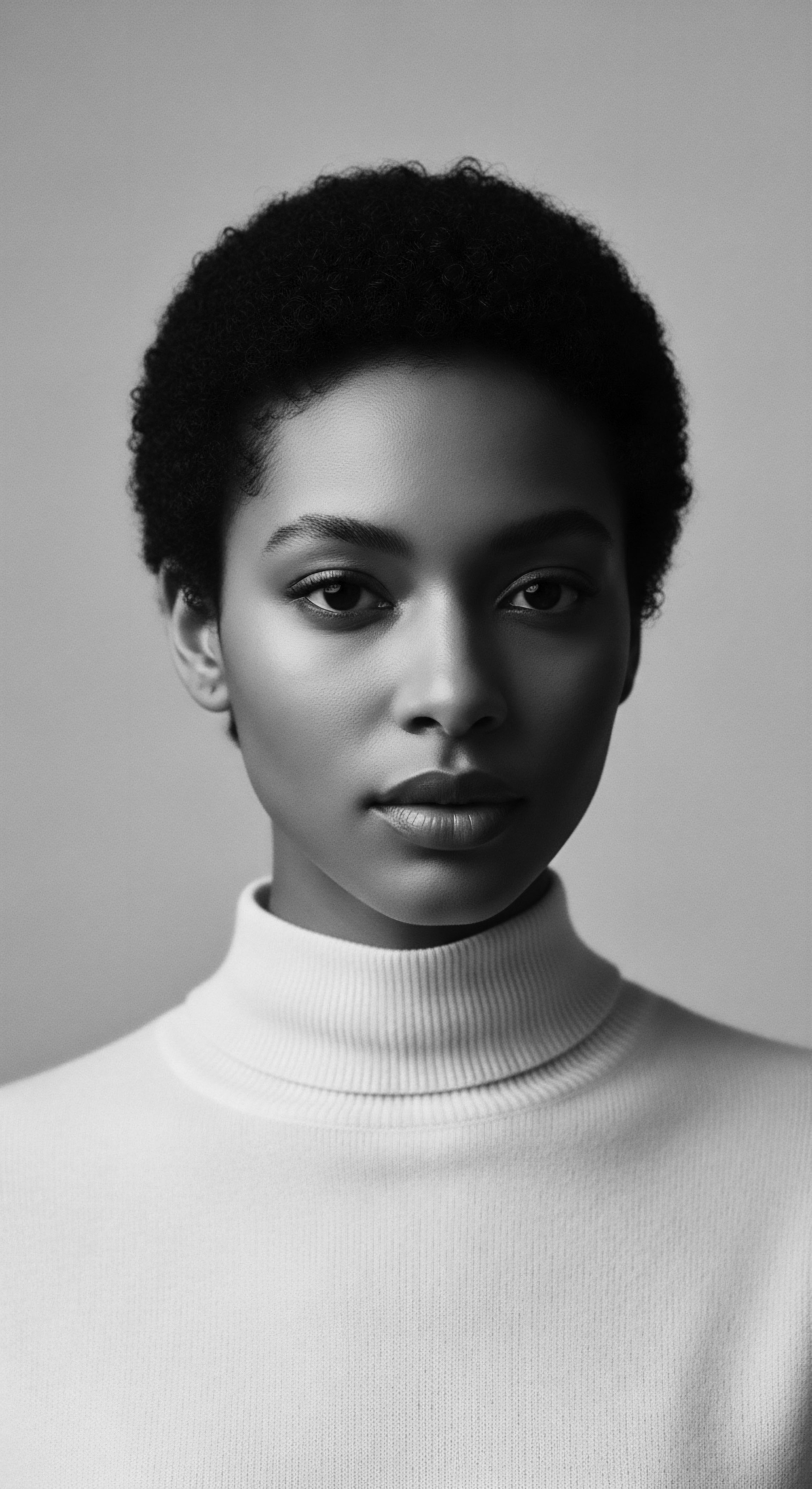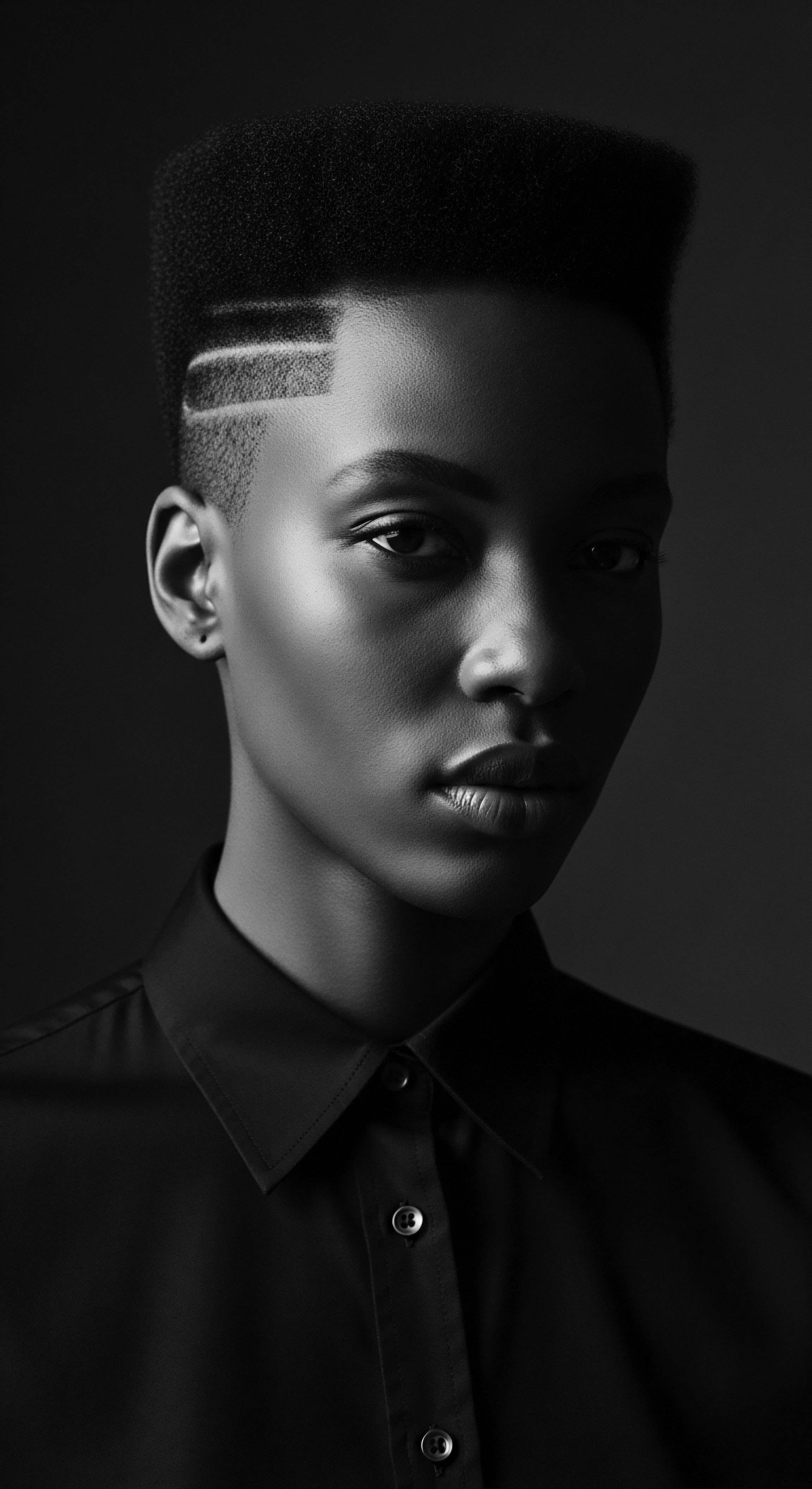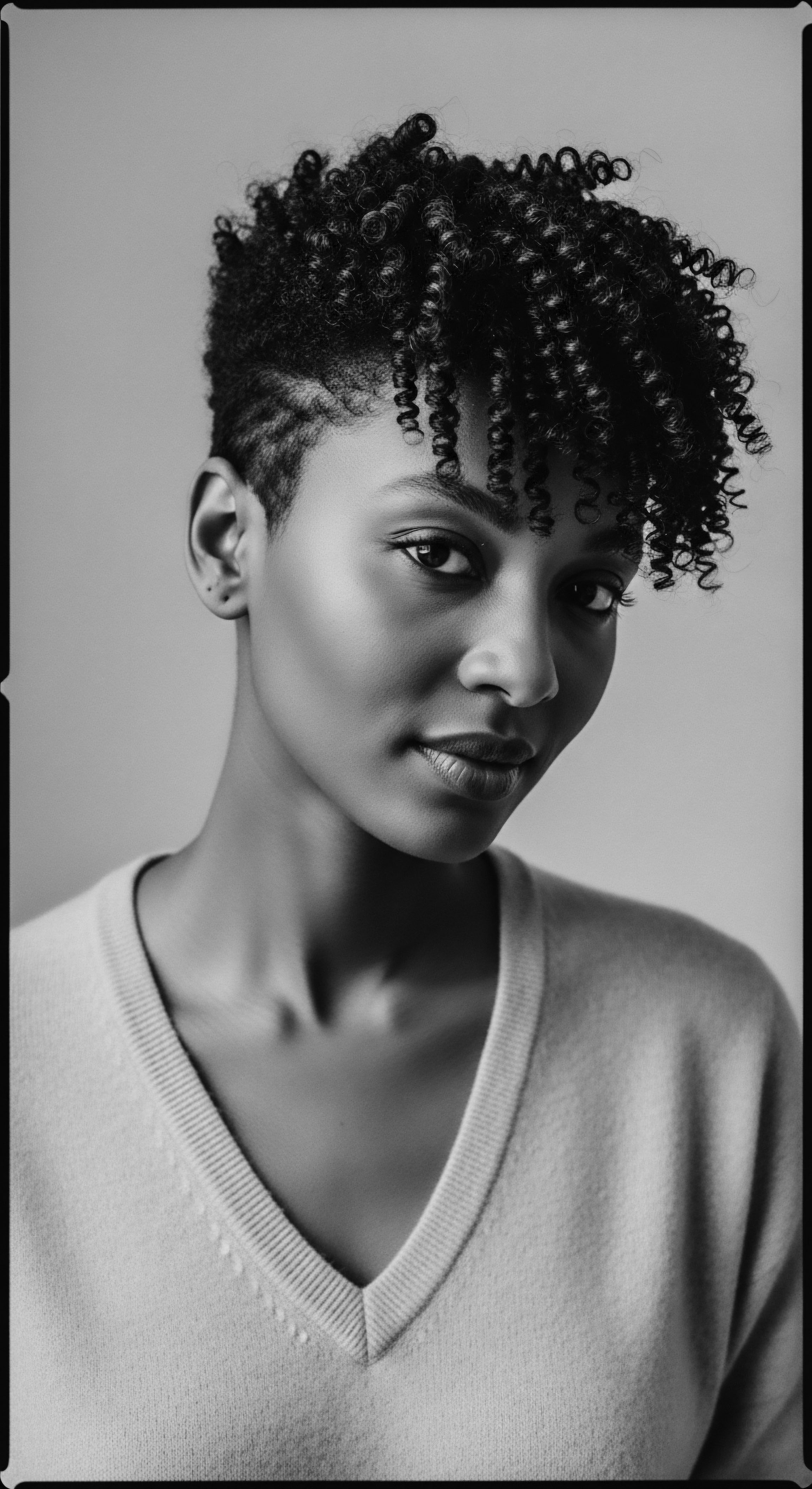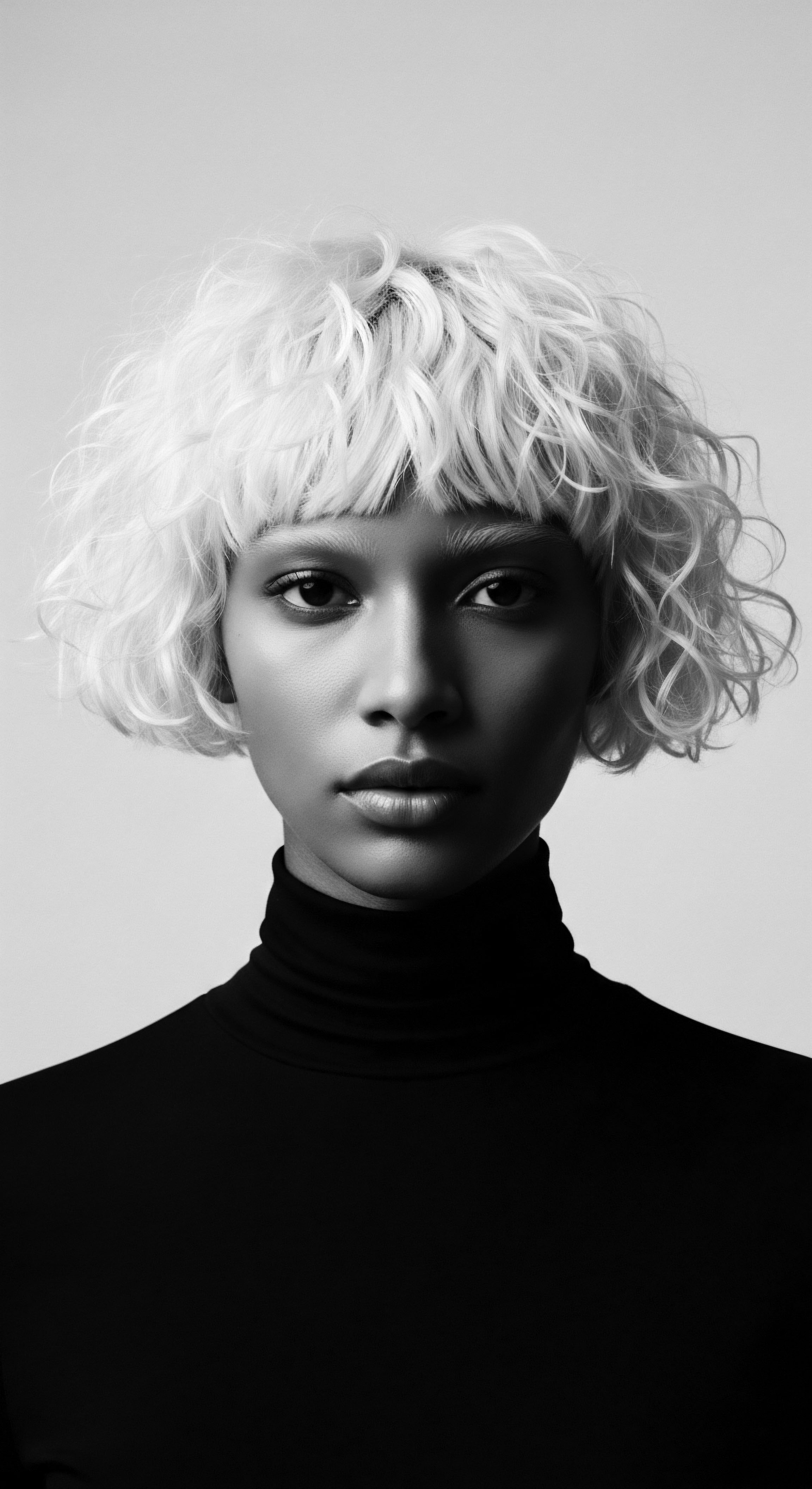
Roots
In every gentle stroke of a comb, in every tender twist of a coily strand, we encounter a truth whispered through generations ❉ textured hair carries a unique energetic signature, one deeply entwined with its very architecture. This characteristic, often felt as a gentle pull or a rich resistance, is friction. It is a fundamental property, not a flaw, that has shaped ancestral practices and defines the resilience of Black and mixed-race hair. To understand how textured hair’s structure increases its friction is to understand a cornerstone of its heritage, a story told in the microscopic spirals of each fiber and the communal wisdom of its care.
Our exploration of this innate quality begins at the source, delving into the very foundations of how textured hair is built. The physics of friction, when applied to a single strand, reveals the ingenious design that protected our ancestors from harsh elements and allowed for the creation of intricate, symbolic hairstyles. These insights echo through time, informing both ancient rituals and contemporary scientific understanding.

The Anatomy of Resistance and Resilience
The structure of textured hair, particularly those with tight curls and coils, significantly contributes to its increased friction. Unlike straight hair, which tends to have a circular cross-section and grows in a relatively straight line from the scalp, hair with pronounced curls exhibits an elliptical or even flattened cross-section and grows with multiple twists and turns. Each bend and curve along the hair shaft acts as a point of contact, creating more opportunities for friction between individual strands and external surfaces. This inherent characteristic causes strands to interlock, forming a denser, often spring-like network.
Consider the cuticle, the outermost layer of the hair shaft. It comprises overlapping scales, much like shingles on a roof. In straight hair, these scales lie relatively flat. In textured hair, however, the scales can be slightly raised or more unevenly distributed due to the hair’s twisted and curved nature.
This unevenness multiplies the points of interaction between adjacent strands, leading to a higher coefficient of friction. This microscopic landscape of scales, while contributing to friction, also plays a role in the hair’s collective strength, forming a natural, protective barrier against the elements—a testament to its evolutionary legacy. The very shape of the follicle, which dictates the curl pattern, ensures that the hair grows not just outwards, but in a way that creates a supportive, interconnected system.
The unique, often elliptical cross-section and spiraled growth pattern of textured hair inherently create more points of contact between strands, leading to increased friction, a characteristic that has both challenged and shaped ancestral care.

Ancestral Adaptations and Historical Functions
The increased friction in textured hair is not an evolutionary oversight; rather, it appears to be a sophisticated adaptation. Historical and anthropological perspectives suggest that this attribute provided distinct advantages for ancestral communities, particularly in regions with intense solar radiation. The dense, interwoven structure created by higher friction offered a natural shield against the sun’s powerful rays, protecting the scalp from harmful UV exposure. This protective quality extended to regulating scalp temperature, allowing air to circulate within the coiled matrix while still providing insulation.
Beyond environmental protection, this inherent friction played a silent, yet powerful, role in cultural practices. The ability of textured hair to hold intricate styles, often for extended periods, directly relates to its natural grip. Without this friction, the elaborate braids, twists, and coils that served as markers of identity, age, marital status, and social standing within many African societies would be challenging to maintain.
This structural property permitted forms of artistic expression and nonverbal communication woven directly into one’s crowning glory. The hair was a living canvas, its architecture allowing for the creation of symbols, stories, and declarations.

Understanding Hair Nomenclature and Its Heritage Link
The language used to describe textured hair has evolved, sometimes reflecting ancestral reverence, at other times embodying colonial bias. Modern classification systems, such as those categorizing hair from wavy (Type 2) to coily (Type 4), attempt to standardize textures. While these systems offer a scientific framework, they fall short of capturing the rich, descriptive terms and cultural significance historically associated with hair types within various communities. Ancestral terminologies often related hair to natural phenomena, emphasizing its strength, versatility, or its resemblance to specific natural forms—a testament to a deep connection to the earth and its rhythms.
For instance, terms in some West African languages might describe hair by its resilience, its ability to “drink” moisture, or its characteristic “spring.” These ancestral descriptions inherently acknowledge the very properties that contribute to friction, viewing them not as an impediment, but as a part of the hair’s vital nature. The concept of “good hair” or “bad hair,” unfortunately, arose from a damaging historical legacy rooted in Eurocentric beauty standards that devalued textured hair, often equating its natural friction and coiling with a lack of manageability or beauty. This linguistic shift erased generations of wisdom that understood and worked with the hair’s inherent characteristics.
The terminology we employ shapes our perception, and understanding the heritage behind these words allows us to reclaim a more respectful and accurate dialogue about textured hair.
- Kinky Hair ❉ A term used to describe tightly coiled, often Z-patterned hair, signifying its unique structural characteristics.
- Coily Strands ❉ Refers to hair that forms very tight, small spirals, often resembling a pen spring, contributing to its collective density.
- Scalp Oiling ❉ An ancient practice involving the application of oils to the scalp, recognized for its role in hair health and minimizing friction during manipulation.
| Hair Structure Trait Elliptical Cross-Section |
| Scientific Observation on Friction Contributes to hair interlock and increased resistance. |
| Ancestral/Cultural Interpretation Foundation for durable protective styles, signifying strength and longevity. |
| Hair Structure Trait Tight Curl Pattern |
| Scientific Observation on Friction Leads to greater strand-on-strand contact and tangling. |
| Ancestral/Cultural Interpretation Natural insulation against climate; a symbol of community and interconnectedness. |
| Hair Structure Trait Cuticle Lifting/Irregularity |
| Scientific Observation on Friction Increases surface roughness and frictional forces. |
| Ancestral/Cultural Interpretation Indicates inherent vitality and the need for nourishing care, often with natural emollients. |
| Hair Structure Trait These observations highlight how the very qualities that increase friction in textured hair were understood and valued in ancestral practices, revealing a deep harmony with its inherent characteristics. |

Ritual
The wisdom of the past, passed down through the hands that shaped and tended textured hair, reveals a profound understanding of its innate friction. This is evident in the intricate rituals of styling that have graced generations, moving beyond simple aesthetics to become acts of cultural preservation and communal strength. The practices, tools, and transformations woven into the heritage of textured hair care speak directly to how communities not only navigated the presence of increased friction but leveraged it as a foundational element of their artistry and survival. This section explores the historical techniques and cultural significances where the concept of friction, though perhaps unnamed, was always at the heart of the interaction with textured hair.

The Styling Heritage and Friction’s Role
Historical styling practices for textured hair, often requiring many hours, underscore the inherent friction of the hair. Unlike hair with less curl, which might glide past itself with relative ease, coiled strands resist separation and readily interlock. This quality, while demanding patience, allows for hairstyles that hold their shape without the need for extensive artificial aids. Traditional braiding, for instance, relies precisely on this interlocking property.
The tightly woven patterns of cornrows, a style dating back thousands of years in Africa, are possible because the hair fibers, when manipulated, create a stable structure that resists unraveling. This resistance is a direct manifestation of the hair’s friction, transforming a biological characteristic into a structural advantage for durable styling.
The practice of braiding itself, a communal affair in many societies, also demonstrates a collective understanding of friction. Hands working together, sometimes applying natural oils or butters, would carefully manage the hair’s natural resistance to create precise patterns. These sessions served as a conduit for storytelling, for sharing history, and for strengthening social bonds. The physical act of braiding, which demands a sustained interaction with the hair’s frictional qualities, was thus integrated into the social fabric of communities.

Ancient Tools, Modern Insights
The tools crafted by our ancestors for hair care offer tangible evidence of their intuitive grasp of friction. Early combs and picks, often fashioned from wood, bone, or metal, featured wide teeth, deliberately spaced to navigate the natural entanglement of coiled hair. A modern scanning electron microscope (SEM) study by Khumalo et al. (2000) observed that human African hair samples, when compared to Caucasian and Asian samples, exhibit a significantly higher incidence of knots (10%-16% versus 0.15%), which readily interlock to form a mat-like structure.
This inherent tendency toward knotting and intertwining underscores the natural resistance textured hair presents to external manipulation, making wide-toothed tools a logical, ancestral innovation to minimize damage caused by excessive friction. The wide spacing reduced the overall surface area of the tool interacting simultaneously with multiple strands, thus decreasing the cumulative drag and potential for breakage.
The continued use of wide-toothed combs in contemporary textured hair care, alongside detangling brushes designed to gently separate curls, acknowledges the enduring challenge of friction in detangling. This echoes an ancestral wisdom that prioritized working with the hair’s natural tendencies, rather than against them. The careful selection of these tools was, and remains, a method for respectful engagement with the hair’s structure.
Traditional hair tools, like wide-toothed combs, embody ancestral wisdom in managing textured hair’s friction, preventing breakage while honoring its inherent coil.

Cultural Transformations and Adornments
Hair has always been a powerful medium for expression, a visible declaration of identity and status. In many African cultures, specific hairstyles, often held in place by the hair’s natural friction, communicated messages about age, marital status, wealth, or tribal affiliation. The addition of adornments, such as beads, cowrie shells, or plant fibers, often relied on the hair’s frictional grip to secure them firmly without slipping. This means that the very ability of the hair to hold these decorations was linked to its structural characteristics.
During the era of enslavement, hair became a symbol of resistance and a clandestine means of communication. Enslaved African women, stripped of their material possessions and cultural markers, wove their heritage into their hair. It is speculated that specific braid patterns or the inclusion of items like rice seeds within hairstyles could serve as maps or indicators of escape routes, utilizing the hair’s ability to hold small items securely within its coiled structure. This historical instance demonstrates an ingenious leveraging of the hair’s friction for survival, a poignant testament to resilience and ingenuity in the face of profound adversity.
The evolution of protective styles also reflects an ongoing dialogue with friction. Styles like Bantu knots, twists, and various forms of braiding, traditionally worn for longevity and hair preservation, manage the collective friction of many strands by keeping them organized and contained. This reduces the individual strand-on-strand friction that can lead to tangling and breakage, especially during daily movement or sleep.
- Cornrows ❉ Ancient braiding patterns lying flat against the scalp, used historically for tribal identification and, during enslavement, as covert maps to freedom.
- Bantu Knots ❉ A protective style where sections of hair are twisted into a coil and wrapped against the scalp, allowing for curl definition when unraveled.
- Shea Butter ❉ A traditional African emollient used to lubricate strands and reduce friction during styling and detangling, aiding in moisture retention.

Relay
The intricate mechanisms behind textured hair’s increased friction are a deep well of scientific inquiry, yet these biological realities are never separate from their human story. To truly grasp the relationship between texture and friction, we must look beyond the purely mechanical, considering how scientific understanding intersects with the profound cultural and historical legacies of Black and mixed-race hair. This requires a synthesis of laboratory findings with the enduring wisdom of ancestral care practices, revealing a continuity that spans centuries.

The Microscopic Dynamics of Frictional Forces
At the micro-level, the helical structure of textured hair plays a primary role in its frictional properties. Unlike the smoother, more cylindrical cross-section of straight hair, each strand of textured hair possesses an elliptical or flattened cross-sectional shape, often varying along its length. Furthermore, the hair shaft itself undergoes multiple twists and turns, creating points where the flat sides of one strand meet and interlock with others. This physical geometry significantly increases the surface area available for inter-fiber contact, directly contributing to higher friction.
Scanning electron microscopy (SEM) studies have shown the complex, undulating paths of individual textured hair fibers and their propensity to intertwine and form dense, sometimes matted, structures. This natural tendency to interlock, a consequence of the hair’s unique curvature and morphology, underpins its distinct frictional profile.
The cuticle layer, composed of overlapping scales, also contributes to this phenomenon. While all hair types possess cuticles, the angle and arrangement of these scales can vary, particularly on the curved surfaces of textured hair. When two textured strands interact, the edges of these cuticle scales can catch on one another, generating resistance. This “ratcheting” effect, while contributing to the hair’s collective volume and ability to hold style, presents a challenge during manipulation, such as combing or brushing.
Research indicates that a high friction coefficient in hair is directly associated with increased resistance to combing and a higher potential for damage. The understanding of this micro-scale interaction is not merely academic; it informs the very tools and techniques passed down through generations for detangling and styling, which prioritize minimizing this frictional stress.

How Does Hair Morphology Influence Its Lubrication?
The scalp produces sebum, a natural oil that helps lubricate hair strands. In straight hair, sebum can travel down the length of the shaft with relative ease, providing a continuous coating that reduces friction. However, with textured hair, the tight coils and turns impede the smooth migration of sebum from the scalp to the ends. This uneven distribution results in drier hair, particularly at the ends, which in turn leads to increased friction between strands.
Dry hair, lacking natural lubrication, experiences higher frictional forces, making it more susceptible to tangling and breakage. This inherent dryness, coupled with the structural predisposition to interlock, means textured hair often requires external moisturizing agents to manage friction effectively.
This scientific insight validates ancestral practices where the application of oils and butters was a central ritual. Across African and diasporic communities, ingredients like shea butter, coconut oil, and various plant-based emollients were consistently used to coat and soften hair. These substances provided an external layer of lubrication, mimicking and supplementing the scalp’s natural oils, thereby reducing friction during manipulation and minimizing breakage. This historical emphasis on moisture and conditioning demonstrates an intuitive, lived understanding of the hair’s needs, long before modern science could explain the precise tribological properties at play.
The tight coiling of textured hair impedes natural sebum distribution, leading to increased dryness and friction, a challenge long addressed by ancestral moisturizing practices.

Mechanical Strain and Environmental Impact
The increased friction in textured hair makes it more vulnerable to mechanical stress. Daily activities, such as styling, detangling, or even simply moving one’s head against surfaces like pillowcases, generate frictional forces that can lead to cuticle lifting, fraying, and breakage. This susceptibility to mechanical damage is a significant concern for textured hair, underscoring the importance of gentle handling and protective practices.
Consider the historical example of the “Tignon Laws” enacted in New Orleans in the late 18th century, which forced Black women to cover their hair in public. While rooted in oppressive intentions to diminish the perceived beauty and status of Black women, these laws inadvertently contributed to a form of hair protection from environmental friction and damage. The forced wearing of headwraps, initially a symbol of subjugation, transformed for many into an act of cultural expression and, functionally, a means to protect hair from external elements and reduce friction with surroundings. The irony remains stark, yet the practical consequence of reduced friction for the hair itself offers a peculiar historical footnote on adaptive care.
The consistent use of protective styles, a hallmark of textured hair heritage, serves as a direct response to this vulnerability. Braids, twists, and updos keep hair strands bundled together, minimizing their individual exposure to friction from clothing, environmental elements, and other strands. This deliberate bundling of hair into organized structures significantly reduces wear and tear, allowing the hair to retain moisture and length, thereby promoting overall health.
The scientific explanation of cuticle integrity and frictional wear thus reinforces the ancestral wisdom embedded in these protective styling traditions. It is a powerful example of how modern scientific inquiry can affirm and deepen our appreciation for long-standing cultural practices.
- Protein Structure ❉ The keratin proteins that form hair fibers are arranged in a specific way within textured hair, contributing to its inherent coiled shape and resistance to deformation.
- Humidity Response ❉ Textured hair’s unique response to humidity can increase friction as water molecules interact with its complex surface, potentially causing swelling and further interlocking of scales.
- Melanin Distribution ❉ While less directly linked to friction, the distribution of melanin in textured hair can influence its mechanical properties, potentially impacting its overall durability against frictional forces.
| Friction-Related Challenge Inter-strand tangling |
| Ancestral Practice/Solution Communal detangling sessions; use of wide-tooth combs. |
| Modern Scientific Recommendation Finger detangling; use of wide-tooth combs and detangling brushes on wet hair. |
| Friction-Related Challenge Dryness leading to increased friction |
| Ancestral Practice/Solution Regular application of natural oils (shea butter, coconut oil) and plant-based emollients. |
| Modern Scientific Recommendation Consistent moisturizing with leave-in conditioners and oils; sealing with heavier butters. |
| Friction-Related Challenge Breakage from mechanical stress |
| Ancestral Practice/Solution Protective styling (braids, twists); wearing headwraps for protection. |
| Modern Scientific Recommendation Low-manipulation styles; sleeping on satin/silk surfaces to reduce friction. |
| Friction-Related Challenge Both historical practices and contemporary science align in addressing the challenges posed by textured hair's friction, emphasizing gentle care and protective measures to preserve its vitality. |

Reflection
The journey through the mechanics of textured hair’s friction, viewed through the lens of heritage, reveals a story of remarkable resilience and profound adaptability. From the subtle nuances of its microscopic architecture to the grand narratives of cultural expression, the increased friction in textured hair is not merely a scientific anomaly. It is, in truth, an elemental characteristic that shaped the very ways our ancestors interacted with, adorned, and celebrated their hair. Each coil, each curve, carries an echo of sun-drenched landscapes and communal gatherings, of resistance in the face of oppression, and of an enduring legacy of beauty.
The care rituals passed down through families, the tools designed with an intuitive understanding of the hair’s nature, and the styles that tell stories of identity and survival, all affirm a deep respect for this unique hair type. In honoring the science that explains friction, and the heritage that understood it long before, we strengthen our connection to the Soul of a Strand, recognizing it as a living archive of wisdom, strength, and vibrant life.

References
- Khumalo, N. P. Doe, P. T. Dawber, R. P. R. & Ferguson, D. J. P. (2000). What is normal black African hair? A light and scanning electron-microscopic study. Journal of the American Academy of Dermatology, 43(5 Pt 1), 814-820.
- Davenport, R. (2014). In Living Color ❉ A Cultural History of Black Hair. Praeger.
- Mercer, K. (1994). Welcome to the Jungle ❉ New Positions in Cultural Studies. Routledge.
- Banks, I. (2000). Hair Matters ❉ Beauty, Power, and Black Women’s Consciousness. New York University Press.
- Byrd, A. D. & Tharps, L. D. (2001). Hair Story ❉ Untangling the Roots of Black Hair in America. St. Martin’s Press.
- Adepegba, O. (2017). Black Hair ❉ The Natural Hair Movement. Bloomsbury Academic.
- Ladson-Billings, G. (1994). The Dreamkeepers ❉ Successful Teachers of African American Children. Jossey-Bass.
- Sweet, T. (2018). The Ultimate Guide to the Care and Styling of Afro-Textured Hair. New Africa Books.
- Tarlo, E. (2016). Entanglement ❉ The Secret Lives of Hair. Oneworld Publications.
- Rajan-Rankin, A. (2021). Hair & The Politics of Identity. Verso Books.
